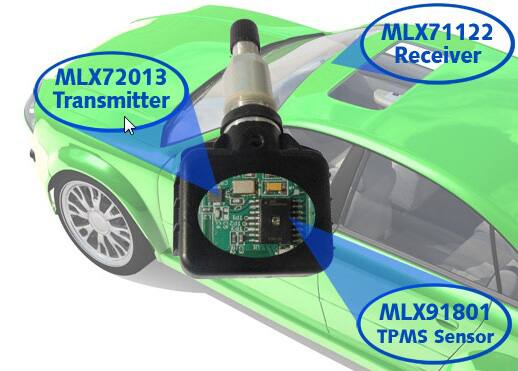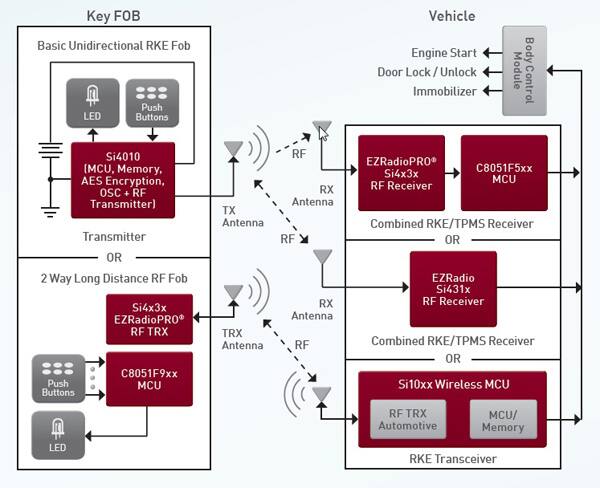Wireless Trends in Cars
投稿人:电子产品
2013-05-16
For years, it was all about GPS and Bluetooth. Today, wireless automotive technology centers on mobile phone integration (the phone is the only wireless off-board device accepted by car manufacturers) as well as developing smart, active safety systems that combine input from GPS, radar sensors, LIDAR (light detection and ranging) optical sensors, and video cameras to determine a car’s position with respect to other vehicles on the road and then warn of potential hazards. Before too long, wireless apps in the car may well encompass V2V (vehicle-to-vehicle) communications to allow automobiles to wirelessly “talk” to each other.
This article will identify some current and emerging trends in automotive wireless systems ,starting with well-understood applications such as tire-pressure-monitoring systems (TPMS) and remote keyless entry access (RKE) and moving on to nascent vehicular technologies such as near-field communications (NFC), in-car connectivity and the not-too-far-off dream of vehicles with the potential to drive themselves. We’ll also offer a review of ‘smart car’ demonstrations presented recently at the 2013 International Consumer Electronics Show.
Tire-pressure-monitoring systems (TPMS)
A tire-pressure-monitoring system, as the name suggests, lets the driver know if there is a problem with tire pressure. Analysts at TechNavio (the syndicated research wing of Infiniti Research) predict the global market for tire pressure monitoring systems to grow at a CAGR of 6.9 percent between 2011 and 2015. According to the analysts this growth is basically due to passenger safety initiatives governments have put in effect.
The core technology behind direct measurement TPMS is the RFIC. Typical TPMS systems monitor tire pressure indirectly by using the vehicle's anti-lock system to detect changes in rotational speed associated with the decreased radius of a deflated tire. Direct measurement methods, however, must employ low-frequency RF devices to transmit tire pressure measurements to vehicle safety management systems. (See the TechZone article “Low-Frequency RFIC Solutions for Tire-Pressure-Monitoring Systems” for more details).
As an example of a typical TPMS, consider Melexis Technologies’ approach (Figure 1), which includes the MLX71122 receiver (27 to 930-MHz FSK/FM/ASK, multichannel programmable), the MLX72013 transmitter (433-MHz ASK/FSK) and the MLX91801 TPMS sensor (Figure 1).

Besides providing automotive-qualified RF transmitters and receivers, near-field communication (NFC) transceivers and pressure sensors, Melexis Technologies offers an EEPROM-configurable system in package solution for TPMS implementations that combines an analog pressure sensor and a low power sensor interface with an MLX16 16-bit RISC-based microcontroller. It is housed in a compact, pressure ported, plastic SO16 package and has an operational temperature range of –40° to 125°C.
Remote keyless entry (RKE)
A remote-keyless-entry system is designed to remotely permit or deny access to an automobile. RKE also is commonly applied in garage opener and alarm systems. A typical RKE system block diagram is shown in Figure 2.

Among the Silicon Labs parts shown in Figure 2 above are the Si4010 fully integrated crystal-less CMOS SoC RF transmitter with an embedded CIP-51 8051 MCU. The device can operate over the –40° to 85°C temperature range without requiring an external crystal reference source reducing board area and BOM cost.
Silicon Labs’ Si4313 EZRadio wireless RF receiver provides designers with features to enable low system power consumption by offloading a number of RF-related activities from the system MCU allowing for extended MCU sleep periods. Additional features, such as an automatic wake-up timer, 64-byte RX FIFO, and a preamble detection circuit, are available. The Si4313's digital receive architecture features an analog-to-digital converter (ADC) and DSP-based modem that performs the radio demodulation and filtering for increased performance.
Silicon Labs’ Si4313 demo kit contains everything a designer needs to evaluate the EZRadio Si4313 RF Receiver. The kit covers the 315-, 434-, 868-, and 915-MHz bands. Similarly, the Si4010 kit has two versions: one for the 434-MHz band and one for the 868-MHz band. The key features of the development platform are as follows:
- The key fob demo board has five push buttons and one LED output.
- The receiver demo board has four LEDs to display received key fob commands.
- The provided software pack contains all the documentation and files needed to develop a user application. The kit supports the use of the Silicon Labs Integrated Development Environment (IDE) for software debugging and the use of the Keil C compiler, assembler, and linker toolchain.
- It contains demo applications using API functions and the key fob demo application.
NFC technology enables smartphones to work with automotive systems. There are five major functions where NFC is used in cars:
- Entry. To enter the car, the driver moves the smartphone in close proximity to the front of the door handle and opens the door.
- Start. The driver places the smartphone in the NFC slot and only needs to press the start button for the engine to start up.
- Personal settings. While the smartphone is in the NFC slot, the driver can change the seat setting and the steering wheel with the driver’s personal settings, which are already stored in the phone. This makes it easy for the driver when others use the same car or when the driver uses another car.
- Diagnostic. The driver doesn’t have to wait for the mechanic to see what is wrong with the car. The driver can access car diagnostic information through a specific application when the smartphone is close to the car’s NFC slot.
- Car lending/sharing. The car owner grants a time-limited key through peer-to-peer communication between phones.
Other wireless trends include various Internet services that are designed exclusively for the car. The car’s wireless network will allow you to connect to the Internet through your smartphone, tablet, or other Wi-Fi device. Today, there is also radar technology which is used for adaptive cruise control and also forward crash avoidance. A key part for such a system is the Analog Devices AD8283 radar receive path AFE, which contains a preamplifier (LNA) with a programmable gain amplifier (PGA) and an antialiasing filter (AAF) plus one direct-to-ADC channel, all integrated with a single 12-bit ADC.
This year’s Consumer Electronics Show (CES) definitely showed the future potential of wireless technology in the car, from using hands-free technology in order to focus on driving, to communicating between cars to avoid accidents.
Some companies demonstrated cars with 4G LTE wireless connectivity. For example, Audi AG unveiled the 2013 Audi A3 with 4G LTE wireless connectivity powered by the second generation Gobi multimode 3G/4G LTE chipset, the MDM9215, from Qualcomm Technologies. With peak data rates approaching 100 Mbits/s, the enhanced “Audi connect” services in the A3 are expected to transform the user experience and provide enhancements to real-time navigation (such as presenting street-level visual imagery streamed to the vehicle), weather, Internet radio, and travel information, as well as providing a Wi-Fi hotspot access point for up to eight devices in the car.
CES 2013 left no doubt that cars will be getting “smarter.” The concept of having a mobile mesh network to help drivers avoid accidents on highways has been around for the past few years, but it will now be supplemented by car-to-cloud/cloud-to-car connectivity services, allowing a driver to track, locate, access, secure and monitor his or her family's vehicles anywhere at any time with a smartphone or browser.
CES presented some panel discussions on mesh networks for cars. Basically, the concept is that whatever you have on your smartphone can be accessed by the car and displayed on the vehicle’s infotainment display. According to a recent market forecast from IMS Research (recently acquired by IHS) the market for Wi-Fi in OEM automotive applications will increase eight-fold over the next seven years in North America and Western Europe.
Research also is focusing on the car communicating with external infrastructure so, for example, in future you could get on a highway and drive your car into a line of wirelessly connected cars moving autonomously (without driver input). The principal technology in play here is vehicle-to-infrastructure (V2I) communication, using wireless communications to allow vehicles to share their position, destination and intended route with a central station, making driving not only safer, but also more fuel-efficient and environmentally friendly.
To that end, last August a wireless communications test among vehicles and roadside equipment in Ann Arbor, MI included nearly 3,000 cars and trucks that were driven on 75 miles of highways equipped with infrastructure that let test vehicles communicate among themselves and with roadside stations. The Ann Arbor road-test vehicles sent electronic data messages and received messages from other equipped vehicles; where necessary, the in-car system translated the data into a traffic hazard warning to the driver.
免责声明:各个作者和/或论坛参与者在本网站发表的观点、看法和意见不代表 DigiKey 的观点、看法和意见,也不代表 DigiKey 官方政策。








 中国
中国